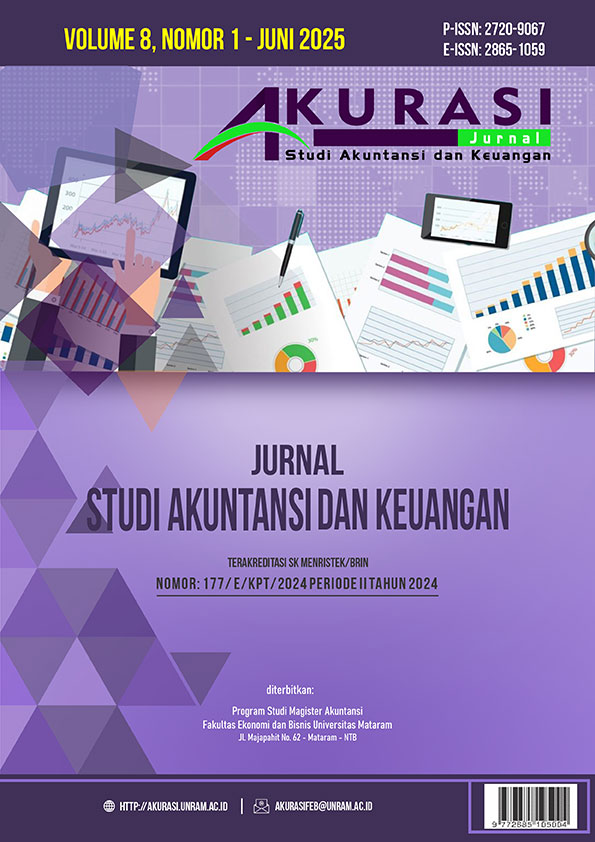INDIVIDUAL PERCEPTIONS OF PUBLIC SECTOR’S RISK CULTURE
DOI:
https://doi.org/10.29303/akurasi.v8i1.689Keywords:
Budaya risiko, manajemen risiko, sektor publik, institute of risk management, teori budaya organisasiAbstract
Effective risk management in the public sector is essential; however, individual perspectives reveal gaps in implementation and a weak risk culture, which increase the potential for errors, fraud, and corruption. This study evaluates individual perceptions that shape organizational culture to support effective risk management at Office B, a public service agency managing a significant budget. A qualitative case study approach was employed using method and data triangulation (document analysis, surveys, and interviews), based on frameworks from the Institute of Risk Management and Schein’s Organizational Culture Theory. The findings indicate that the risk culture is "partially fulfilled", with most individuals classified as composed, moderately risk-aware but passive and compliance-oriented. Risk-based decision-making is reactive, and risk communication remains limited due to fear of consequences. The underlying culture emphasizes formality, compliance, and caution. Office B must strengthen its risk culture through leadership, transparency, and structured training.
Downloads
References
Alkhyyoon, H., Abbaszadeh, M. R., & Zadeh, F. N. (2023). Organizational risk management and performance from the perspective of fraud: A Comparative Study in Iraq, Iran, and Saudi Arabia. Journal of Risk and Financial Management, 16(3). https://doi.org/10.3390/jrfm16030205
Azria, R. N., & Diyanty, V. (2023). Evaluasi budaya risiko menggunakan risk culture aspect model (studi kasus pada direktorat jenderal X). Jurnal Akuntansi Manado, 4(2), 226–248. https://doi.org/10.53682/jaim.vi.6604.
Bin Husayn, A., Abdullah, M., & Rimmel, G. (2025). The relationship between risk perception and risk management: a systematic literature review. Journal of Risk Research, 27, 1–18. https://doi.org/10.1080/13669877.2024.2447258
Br Karo Sekali, R. (2024). Evaluasi atas implementasi budaya risiko pada perusahaan finansial ABC. Owner, 8(3), 2225–2234. https://doi.org/10.33395/owner.v8i3.2167
Bracci, E., Tallaki, M., Gobbo, G., & Papi, L. (2021). Risk management in the public sector: a structured literature review. International Journal of Public Sector Management, 34(2), 205–223. https://doi.org/10.1108/IJPSM-02-2020-0049
Ceschi, A., Dusi, M., Ferrara, M., Tommasi, F., & Sartori, R. (2025). Individual differences in risk attitude among managers: a multilevel approach. International Journal of Organizational Analysis, 33(12), 1–17. https://doi.org/10.1108/IJOA-02-2024-4251
Committee of Sponsoring Organizations (COSO). (2017). Enterprise risk management integrating with strategy and performance. In The Committee of Sponsoring Organizations of the Treadway Commission: Vol. I (Issue June). https://www.coso.org/Documents/2017-COSO-ERM-Integrating-with-Strategy-and-Performance-Executive-Summary.pdf
Corruption Eradication Commission. (2024). Gratification report based on agency. https://www.kpk.go.id/id/publikasi-data/statistik/gratifikasi-1
Ersyafdi, I. R., & Ginting, R. (2024). Gratifikasi dalam perspektif mahasiswa akuntansi: Dilema atau probelamtika. Akurasi : Jurnal Studi Akuntansi Dan Keuangan, 7(1), 17–34. https://doi.org/https://doi.org/10.29303/akurasi.v7i1.478
Ghafoori, E., Mata, F., Faulkner, N., & Tear, M. J. (2023). Measuring risk culture in finance: Development of a comprehensive measure. Journal of Banking and Finance, 148, 106720. https://doi.org/10.1016/j.jbankfin.2022.106720
Goverment Financial Institutional. (2025). Annual report 2024.
Grieser, F., & Pedell, B. (2022). Exploring risk culture controls: to what extent can the development of organizational risk culture be controlled and how? Journal of Accounting and Organizational Change, 18(5), 752–788. https://doi.org/10.1108/JAOC-11-2020-0189
Hogan, S. J., & Coote, L. V. (2014). Organizational culture, innovation, and performance: A test of Schein’s model. Journal of Business Research, 67(8), 1609–1621. https://doi.org/10.1016/j.jbusres.2013.09.007
Ilias, A., Baidi, N., Ghani, E. K., & Omonov, A. (2023). A qualitative investigation on risk management implementation in the Malaysian public sector. Economic Affairs (New Delhi), 68(2), 1247–1261. https://doi.org/10.46852/0424-2513.2.2023.30
Kelly, P. (2023). Are you competent coping with uncertainty and risk? Implications for work-applied management. Journal of Work-Applied Management, 15(2), 241–251. https://doi.org/10.1108/JWAM-10-2022-0071
Kusev, P., Purser, H., Heilman, R., Cooke, A. J., Van Schaik, P., Baranova, V., Martin, R., & Ayton, P. (2017). Understanding risky behavior: The influence of cognitive, emotional and hormonal factors on decision-making under risk. Frontiers in Psychology, 8(FEB), 1–10. https://doi.org/10.3389/fpsyg.2017.00102
Lam, J. (2017). Implementing enterprise risk management. In Implementing Enterprise Risk Management. John Wiley & Sons, Inc.
Mahama, H., Elbashir, M., Sutton, S., & Arnold, V. (2020). New development: Enabling enterprise risk management maturity in public sector organizations. Public Money and Management, 0(0), 1–5. https://doi.org/10.1080/09540962.2020.1769314
Merriam, S. B. (2009). Qualitative research a guide to design and implementation revised and expanded applications in education research and case study applications in education. Jossey-Bass A Wiley Imprint.
Murr, P., & Carrera, N. (2022). Institutional logics and risk management practices in government entities: evidence from Saudi Arabia. Journal of Accounting and Organizational Change, 18(1), 12–32. https://doi.org/10.1108/JAOC-11-2020-0195
Osman, A., & Lew, C. C. (2021). Developing a framework of institutional risk culture for strategic decision-making. Journal of Risk Research, 24(9), 1072–1085. https://doi.org/10.1080/13669877.2020.1801806
Pangesti Mulyono, R. D. A. (2020). How important risk management culture in local governments? Journal of Governance and Public Policy, 7(1), 35–40. https://doi.org/10.18196/jgpp71121
Park, Y. J. (2019). Risk culture and risk management in the Australian public sector. In The Australian National University (Issue April). https://doi.org/10.25911/5dd7ab6962108
Rahim, A., Rosid, M. H. O., & Hasan, N. (2024). Risk culture and employee performance for optimal organizational success: the mediating role of employee satisfaction and employee engagement. Management Research Review, 47(11), 1722–1749. https://doi.org/10.1108/MRR-12-2023-0892
Rana, T., Wickramasinghe, D., & Bracci, E. (2019). New development: Integrating risk management in management control systems—lessons for public sector managers. Public Money and Management, 39(2), 148–151. https://doi.org/10.1080/09540962.2019.1580921
Sari, Y., & Setyaningrum, D. (2022). Risk management in public educational institution (case study at XYZ education and training center). 129. https://doi.org/10.4108/eai.10-8-2022.2320878
Saunders, M. N. K., Lewis, P., & Thornhill, A. (2023). Research methods for business students (9th ed.). Pearson Education Limited.
Schein, E. H. (2010). Organizational cultural and leadership (4th ed.). Jossey-Bass A Wiley Imprint.
Sheedy, E., & Griffin, B. (2017). Risk governance, structures, culture, and behavior: A view from the inside. Corporate Governance: An International Review, 26(1), 4–22. https://doi.org/10.1111/corg.12200
Streicher, B., Bielefeld, M., & Eller, E. (2023). The risk culture framework: Introducing an integrative framework for holistic risk analysis. SAGE Open, 13(3), 1–10. https://doi.org/10.1177/21582440231191789
Suardini, D., Rahmatunnisa, M., Setiabudi, W., & Wibowo, C. B. (2018). The existence of risk culture in risk management implementation on the West Java provincial government. European Research Studies Journal, 21(Special Issue 3), 488–502. https://doi.org/10.35808/ersj/1404
Tarjo, T., Vidyantha, H. V., Anggono, A., Yuliana, R., & Musyarofah, S. (2022). The effect of enterprise risk management on prevention and detection fraud in Indonesia’s local government. Cogent Economics and Finance, 10(1). https://doi.org/10.1080/23322039.2022.2101222
The Institute of Risk Management. (2012a). Risk culture: Under the Microscope Guidance for Boards. Protiviti.
The Institute of Risk Management. (2012b). Risk Culture Resources for Practitioners. Protiviti.
Trickey, G. (2019). Risk Type Compass Technical Manual: Fourth Edition (Issue 86). Psychological Consultancy Ltd.
Weber, E. U., & Milliman, R. A. (1997). Perceived risk attitudes: Relating risk perception to risky choice. Management Science, 43(2), 123–144. https://doi.org/10.1287/mnsc.43.2.123
Wicaksono, K. W. (2015). Akuntabilitas organisasi sektor publik. JKAP (Jurnal Kebijakan Dan Administrasi Publik), 19(1), 17. https://doi.org/10.22146/jkap.7523
Yin, R. K. (2018). Case study research and applications: Design and methods (6th ed.). SAGE.
Zhang, Q., Wang, X., Miao, L., He, L., & Wang, H. (2022). The effect of chronotype on risk-taking behavior: The chain mediation role of self-control and emotional stability. International Journal of Environmental Research and Public Health, 19(16068). https://doi.org/10.3390/ijerph192316068
Downloads
Published
How to Cite
Issue
Section
License
Authors who publish in Akurasi: Jurnal Studi Akuntansi dan Keuangan agree to the following terms:
- Authors retain the copyright of their articles.
- Authors grant Akurasi: Jurnal Studi Akuntansi dan Keuangan the right of first publication.
- Articles are licensed under the Creative Commons Attribution-ShareAlike 4.0 International License (CC BY-SA 4.0).
- This license allows anyone to copy, distribute, display, and adapt the articles for any purpose, including commercial use, as long as proper credit is given to the author(s) and the source, and derivative works are distributed under the same license.
- All published articles are open access and may be used for educational, research, and scientific purposes.
License: 
This work is licensed under a Creative Commons Attribution-ShareAlike 4.0 International License.







